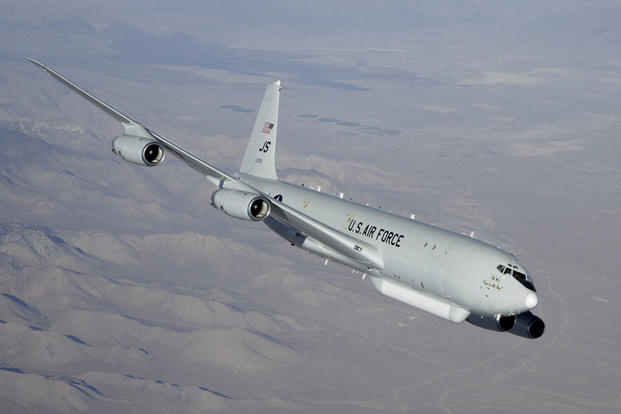The Air Force awarded three contracts for modernization of its high tech radar surveillance plane designed to scan large geographical areas for activity, the Joint Surveillance Target Attack Radar System, or JSTARS, service officials said.
Describing the effort as a recapitalization, or recap, the service is looking at a range of airframes from Gulfstream jets to Bombardier airplanes and Boeing 737-700's as potential replacements for its aging fleet of 16 E-8C JSTARS airplanes.
Lockheed Martin, Northrop Grumman, and Boeing were awarded contracts with a combined value of $31.4 million with options for further designs, Air Force spokesman Ed Gulick said in a statement.
Each contract entails a base period to complete initial requirements analysis, a full system requirements review, and technical reports and analyses, he added.
"Our team awarded contracts ahead of schedule, and we are rapidly progressing toward a Milestone A decision to enter into the technology maturation and risk reduction phase," Col. Dave Learned, JSTARS Recap senior materiel leader, said in a written statement. "Bringing together our government and industry teams for this effort is a major step toward recapitalizing E-8C's combat-proven capabilities."
Boeing is offering a version of its 737-700 business jet, Lockheed is offering something from Bombardier and Northrop is competing with a Gulfstream jet, according to a report from Flightglobal.
“The next-generation JSTARS will replace airframes built in the mid to late 60s. They have the highest number of flying hours on them of any plane in the Air Force. They were refurbished in the 80s and 90s, but they are still old airplanes with some of the most modern technology inside,” Col. Henry Cyr, Commander of the 461st Air Control Wing, Robins Air Force Base, Ga., said last year.
The current JSTARS, manufactured by Northrop Grumman, uses a 24-foot long radar capable of synthetic aperture radar which can paint a rendering or “picture” of the terrain below and Ground Moving Target Indicator, or GMTI, mode, which enables it to detect moving objects.
The platform is uniquely configured for command and control, battle management as well as intelligence, surveillance and reconnaissance, or ISR, missions, Cyr said.
“The intent is to build a capability that provides an equivalent to JSTARS. The Air Force is not planning to make it fundamentally different or make it significantly better in performance. The current capability is fantastic. The initial intent is to get a replacement out quickly and have the ability to spiral in better capability later on,” Cyr said.
With its ability to monitor the ground below and process large areas of collected data, images and information, the JSTARS can help orient smaller ISR platforms, such as a Predator drone, and tell them where to go look more closely with higher fidelity sensors, Air Force leaders explained.
The current JSTARS is based on a four-engine Boeing 707. Of the 16 JSTARS currently in the Air Force inventory, 11 of them are operational. The JSTARS is the only platform technically able to simultaneously perform command and control as well as ISR, service officials explained.
The crew of a JSTARS, which can go up to 21 people or more, includes a navigator, combat systems operator, intelligence officers, technicians and battle management crew officers, Air Force officials said.
As for the airframe, service officials have said the service is examining a range of options.
However, service officials have said that the next-generation JSTARS will not be a wide-body airplane or a 767 like the tanker but will rather be a business jet.
The Air Force hopes to engineer the platform such that it can easily accommodate new technologies such as sensors, computers, avionics and other electronic systems, as they emerge.
Although initially constructed as a Cold War technology to monitor Soviet Union tank movements in Eastern Europe, the JSTARS has proven helpful in areas such as near North Korea, Iraq and Afghanistan. The platform has also succeeded in performing maritime missions in the Pacific, U.S. Southern Command, and Central Command areas of responsibility.
The JSTARS has been able to help meet the fast-expanding maritime demand for ISR and command and control due to an upgrade of its radar to Enhanced Land/Maritime Mode, Air Force officials explained.
JSTARS has also expanded into homeland defense and law-enforcement missions as well, service officials added.
-- Kris Osborn can be reached at kris.osborn@military.com




























